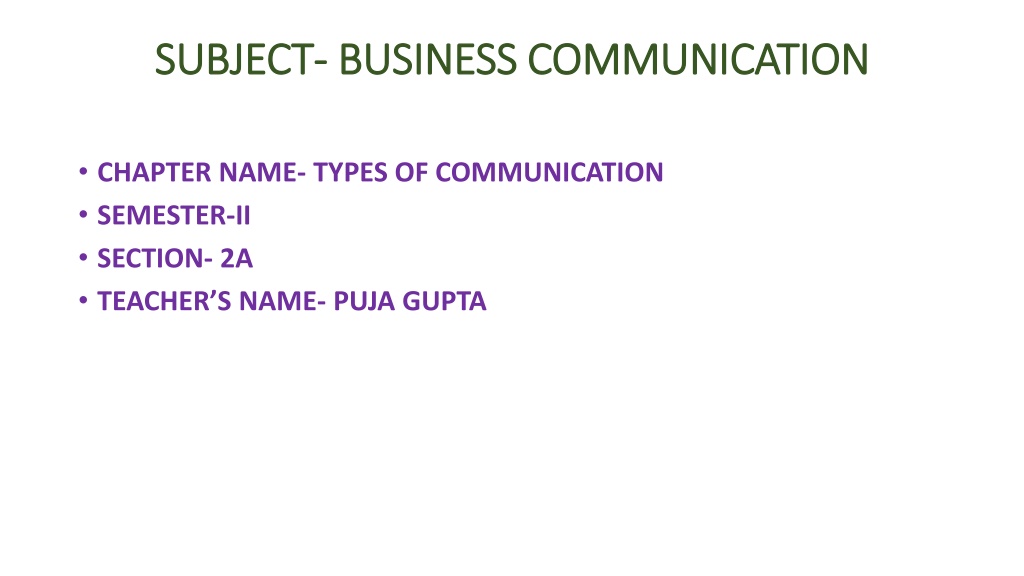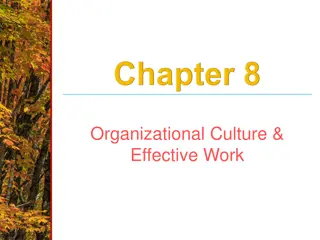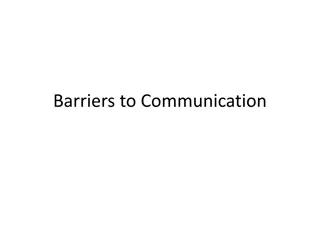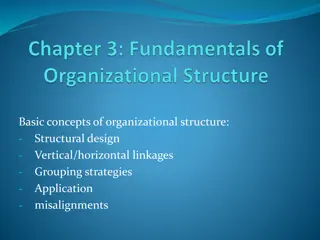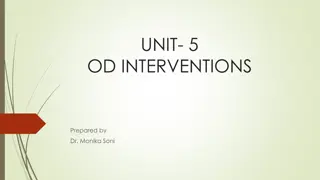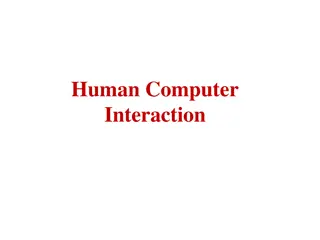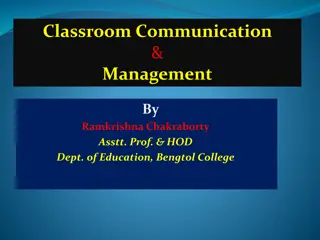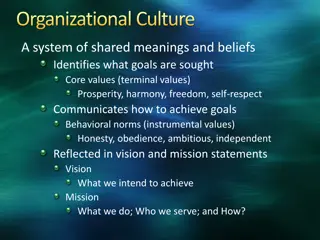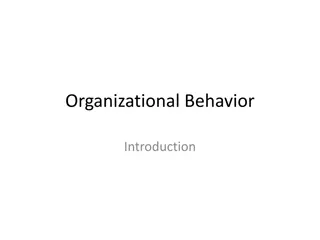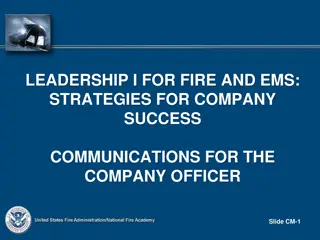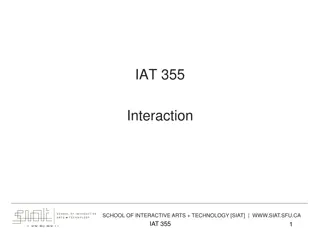Understanding Various Types of Business Communication for Effective Organizational Interaction
Explore the diverse forms of communication within a business context, including formal and informal channels, vertical communication, and different modes of expression like oral, written, and gestural. Understand the advantages and disadvantages of each type to enhance communication efficiency and effectiveness in organizational settings.
- Business Communication
- Types of Communication
- Formal Communication
- Organizational Relationship
- Vertical Communication
Download Presentation

Please find below an Image/Link to download the presentation.
The content on the website is provided AS IS for your information and personal use only. It may not be sold, licensed, or shared on other websites without obtaining consent from the author. Download presentation by click this link. If you encounter any issues during the download, it is possible that the publisher has removed the file from their server.
E N D
Presentation Transcript
SUBJECT SUBJECT- - BUSINESS COMMUNICATION BUSINESS COMMUNICATION CHAPTER NAME- TYPES OF COMMUNICATION SEMESTER-II SECTION- 2A TEACHER S NAME- PUJA GUPTA
TYPES OF COMMUNICATION TYPES OF COMMUNICATION On the basis of organizational relationship Formal communication Informal communication On the basis of flow of information Vertical communication Upward communication Downward communication Crosswise communication Horizontal communication On the basis of expression Oral communication Written communication Gestural communication
FORMAL COMMUNICATION FORMAL COMMUNICATION MEANING:- when communication flows through the predefined official lines it is known as formal communication. It is generally a written form of communication and can take the form of requests, commands, directives, circulars, reports, memos, etc. ADVANTAGES:- Form of written communication Smooth flow of information Fixation of authority responsibility Most reliable Better decision making and control Cooperation and coordination Promotes better understanding Most widely used DISADVANTAGES:- Time taking and slow process lack of personal touch Inflexible Fails to establish a cordial relationship.
INFORMAL COMMUNICATION INFORMAL COMMUNICATION MEANING:- informal communication is free from official rules and regulations and takes place due to personal needs of the sender and receiver of the message. It is also known as Grapevine communication. ADVANTAGES:- Increase employee satisfaction Increase efficiency Reducing employees stress Satisfies the social and psychological needs Get a clear understanding about the attitude and response of the employees Bridges the gap in the formal communication network Greater flexibility DISADVANTAGES:- Spread of distorted messages Leads to rumours Fixation of responsibility is not possible Leads to misunderstanding and misrepresentation of information.
VERTICAL COMMUNICATION( DOWNWARD) VERTICAL COMMUNICATION( DOWNWARD) MEANING:- downward communication refers to the flow of messages from a supervisor to subordinates. In downward communication information flows in the form of orders, instructions, decisions, etc. from individuals in higher hierarchical levels to individuals in lower level following the line of authority. ADVANTAGES:- Informing and explaining policies and organizational procedures Scalar principle Message is continuous Delegation of authority and responsibility Establishing official discipline increase employee efficiency DISADVANTAGES:- Delay the timely functioning of an organization Distortion of message Over communication or under communication Contains subject matter without adequate explanation Labour management relationship may be hampered.
UPWARD COMMUNICATION UPWARD COMMUNICATION MEANING:- Upward communication implies the flow of information from the individual in a lower hierarchical level to individual in a higher hierarchical level that is from subordinates to superiors in the organization. ADVANTAGES:- Greater feedback Constructive suggestions for the progress on the organization Industrial peace Loyalty and commitment Helps the management in decision making process Change in organizational rules, regulations and policies DISADVANTAGES:- Message may get distorted Strained relationship Employees fear that their suggestion treated as their weakness.
HORIZONTAL COMMUNICATION HORIZONTAL COMMUNICATION MEANING:- Horizontal communication refers to flow of information between individual and groups belonging to the same or different department but belong to the same hierarchical level of an organization. ADVANTAGES:- Reduce misunderstanding between individuals Resolving conflicts Increase efficiency and productivity Helps in building cooperation and a friendly work environment DISADVANTAGES:- Minimise the control and power of the management of an organization Rise to conflicts, intergroup rivalry and gossips Leads to disorder in the organization.
DIAGONAL OR CROSSWISE COMMUNICATION DIAGONAL OR CROSSWISE COMMUNICATION MEANING:-Diagonal communication refers to the flow of information between individuals of an organization who do not belong to the same department or same hierarchical level. ADVANTAGES:- faster transmission of message Increase coordination Improving mutual understanding between superiors and subordinates Increase in the morale DISADVANTAGES:- Time consuming Rise to create misunderstandings and conflicts Subordinates may hesitate to make commitment beyond their authority.
ORAL COMMUNICATION ORAL COMMUNICATION MEANING:- oral communication means transmission of message from the communicator to the communicate through spoken words , which may be through face to face contact or by the use of some mechanical devices. ADVANTAGES:- Faster transmission of message Greater understanding Personal contact Create a healthy working environment Flexible Helps in building inter personal relationship between superior to the subordinates Communicating confidential information DISADVANTAGES:- Not suitable for communicating lengthy messages Not suitable for communicating to a large number of receivers at a time Absence of active listening Message being filtered or getting distorted.
WRITTEN COMMUNICATION WRITTEN COMMUNICATION MEANING:- written communication refers to transmission of information through written letters, circulars, memos, orders, reports, bulletins etc.. Thus in the case if written words are the basis of sending messages , orders, instructions etc. ADVANTAGES:- Provide documentary evidence Communicator can reach simultaneously to many receivers of a message Communicating lengthy message More effective Precise and very accurate Using statistical data and pictorial presentations Uniformly applicable DISADVANTAGES:- Time consuming and costly Lack of personal touch It make the communication process clumsy.
GESTURAL COMMUNICATION GESTURAL COMMUNICATION MEANING:- It is communication through body language like facial expression, movements of the head, tone of voice or even smile. It is a combination of oral and written communication. ADVANTAGES:- Faster and more effective Substitute if verbal communication that is where silence speaks better than words DISADVANTAGES:- Communication tends to be unclear Not applicable for transmission of official information.
CORPORATE COMMUNICATION CORPORATE COMMUNICATION MEANING:- corporate communication is the transmission of information between different individuals within framework and the transmission of information to the different interested parties to an organization in its outside environment. It is includes both internal and external communication. IMPORTANCE:- Increase in coordination Link with the outside world Employee motivation Effective management Continuous flow of information Attainment of success Better and faster decision making Use of modern technology Training. the organizational structural
STEPS IN CORPORATE COMMUNICATION STEPS IN CORPORATE COMMUNICATION Situation analysis Setting the objectives after proper situation analysis Selection of a strategic plan Assessment of the effect of communication Attaining feedback through continuous monitoring .
